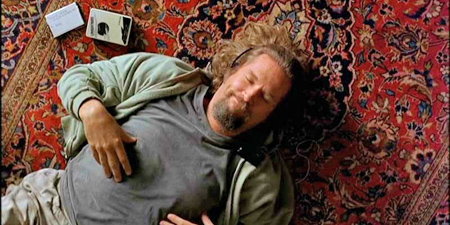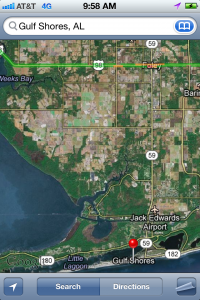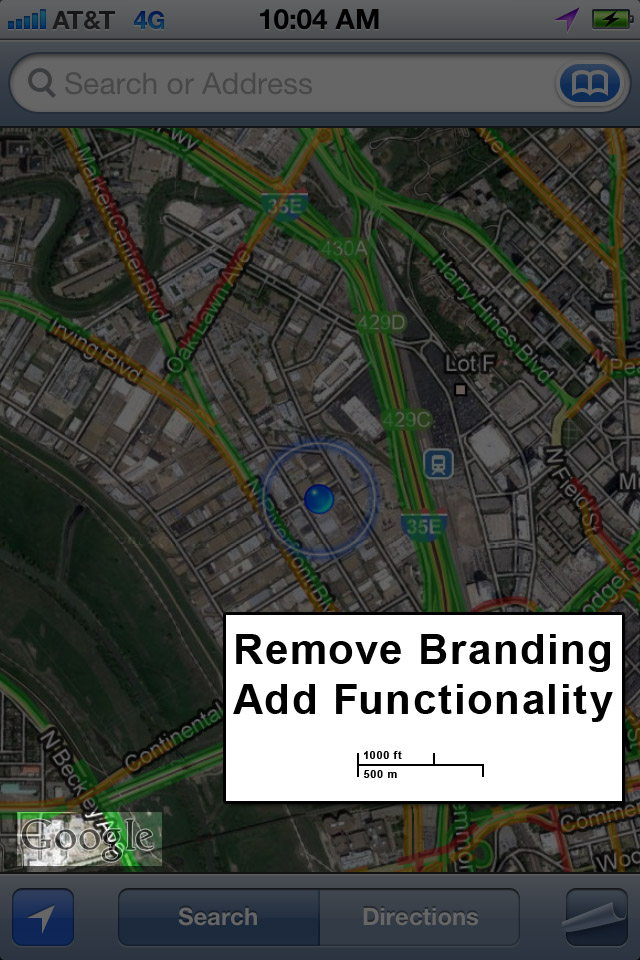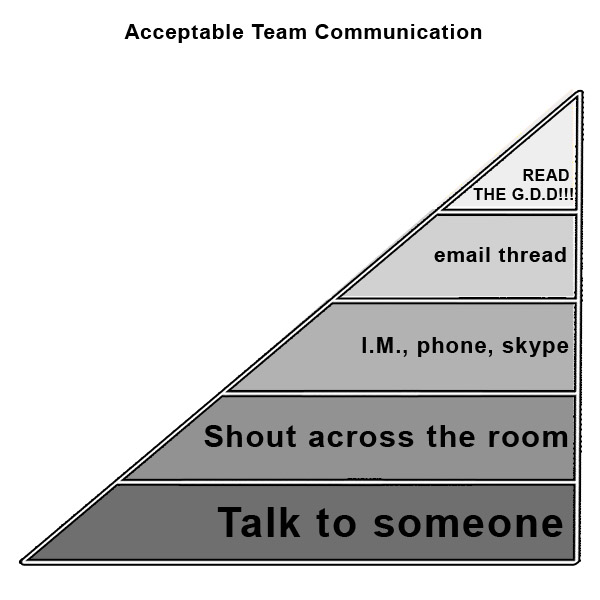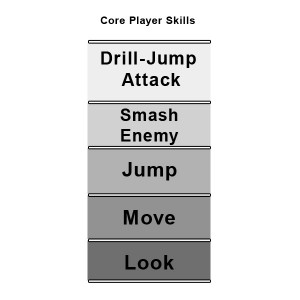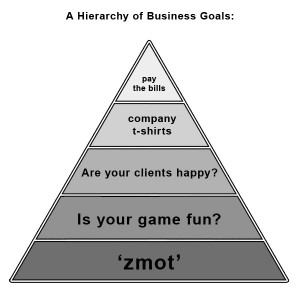We moved offices, shipped two games, and updated a third. Then we updated one of the new games with a mega patch that I’m very proud of and can talk about soon. Busy Fall.
TweetiOS, Android, and Maps – What’s STILL missing
It’s a Map Emergency!
The Map Apps on both Android and iOS are missing a major feature- any sense of SCALE.
Maps are amazing things, abstracted or detailed, they provide an amazing amount of information to the user. So why has the scale been left out of mobile maps?
Below is an image of Apple’s new iOS 6 map app. It’s vector based, and provides turn-by-turn navigation. But it’s still missing a scale.
Recently, I was on a family vacation out of state. We were in the southern flatlands; coastal Alabama. There are almost no visible geographic features. Nothing to guide you.
This is what a glance at my phone’s map showed me:
- How long should it take to reach point x,y from here? I don’t know! I’d have to type in directions and plot a course.
- How far is our rental in Gulf Shores from a restaurant in Orange Beach? I don’t know!
- I can’t just glance at the map and have any knowledge of the size of that wedge of earth that is being displayed. I can guess, based on the size of farm fields or runways in the satellite imagery…sure.
Remove the Branding and Add Functionality!
All I want is to know at a glance how far away something is, regardless of how zoomed in or out I am.
TweetVisual Hierarchies & Game Development
Triangles of Power
Hierarchies are useful. They are meant to help us make decisions based on simple and definable categories.
I’m not really interested in hierarchies in an academic sense. I’m more interested in quick, well organized, rememberable “adages”. We can use these to help make better games, business decisions, or solve any number of problems; hierarchies are cheat sheets.
Ladders
A perennial favorite hierarchy in game development is Maslow’s, which I learned in College Psych, and the game community has been aware of in some way, probably since I was 12. I’m not bringing it up to discuss the merits of providing creature comforts within virtual worlds.
What I find interesting is the graphic representation of the Hierarchy of Needs. His hierarchy requires a step-by step ladder approach. Without a bottom rung to stand on, the body quickly tires and loses grasp of an upper rung. And being a triangle, it is smaller at the top, and wide at the bottom. This graphic characteristic automatically triggers our monkey-minds to assume that the base is most important, yet the peak is most desirable. You can innately understand the relationships between food and sleep, and make an informed assumption that it’s likely that most of the world will never reach the top of Maslow’s ladder (or at least stay there forever).
Hierarchies as Prioritization
I’m a big fan of crossfit (the fitness protocol you either love or hate). One thing I latched onto when I first started scouring the crossfit website was “A Theoretical Hierarchy of Development”.
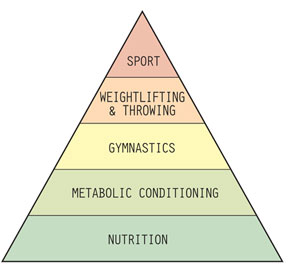
A Theoretical Heirarchy of Development
A theoretical hierarchy exists for the development of an athlete. It
starts with nutrition and moves to metabolic conditioning, gymnastics, weightlifting, and finally sport. This hierarchy largely reflects
foundational dependence, skill, and to some degree, time ordering
of development. The logical flow is from molecular foundations,
cardiovascular sufficiency, body control, external object control,
and ultimately mastery and application. This model has greatest
utility in analyzing athletes’ shortcomings or difficulties.
We don’t deliberately order these components but nature will. If
you have a deficiency at any level of “the pyramid” the components above will suffer. (link)
Serious athletes may come crashing down on me with valid reasons why “The Hierarchy of Development” is wrong. Or maybe it’s the best and simplest expression of fitness yet. Either way, I think crossfit has basically posited this little pyramid as the “if all else fails, try this” lesson plan. Like Maslow’s, the Crossfit hierarchy is based on lower levels being the foundation. It’s obvious that without nutrition, the rest of our world is going to be a mess. But why order the rest of the items like they did? Why does Weight lifting lead to Sport instead of Cardio? I don’t know- I’m not a trainer, or scientist.
It doesn’t really matter. One strength of the triangle is how easy it is to see the orientation of its elements. Base: foundation. Peak: goal. In other words, as a cheat sheet, the abstracted message is clear: Though your goal might be to do well in a specific sport, most of what determines your success will happen outside of that sport. Most of your effort must go into the basics.
P.S. I’d add another wedge to the Crossfit cake. Sleep should be on bottom.Defining Cohorts
One effective use of a hierarchy is for organizing the defining traits of things that you need to interact with. Your RPG characters should be graphed as pyramids in as many ways as necessary. Guns for your iOS Shooter-that-will-show-them-all-that-FPS-has-arrived-on-iOS can be sorted, or even defined in this manner as well. And then, there’s your co-workers:
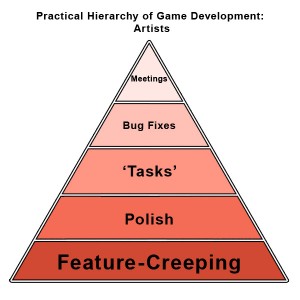
Use in Gamedev
So – what’s the actual use, what can you do with these buggers?
Post them on walls in the office
(Don’t go overboard with triangles on walls, this is not some ini-tech motivational poster I’m talking about.)
use them in your game design
This one would be good to tack next to the pc of your level designer.
Prioritize business goals:
How many of us even have goals, let alone prioritize them?
Not just Triangles!
Of course, not all relationships can use a Δ. I focused this note on triangles because of their overwhelming use with classic hierarchies. But I won’t neglect other shapes. I’ll come back with later posts on Visual Design to cover more.
TweetSo this was a Valued Rug?
Hi-
This is somewhat of a stickynote. I started valued-rug.net so that I could get back into web development, and eventually do some html5 games. What will most likely happen is that this blog will be a scattershot hobby list of things that I find cool. At least until I decide on a focus.
Most of what the site is for is me messing around under the hood on various subdomains. I’m a game developer, but I also work at a teeny tiny company, so I need a site like this to expand my chops.
I taught myself most of the technical skills that I have- this is fun.
